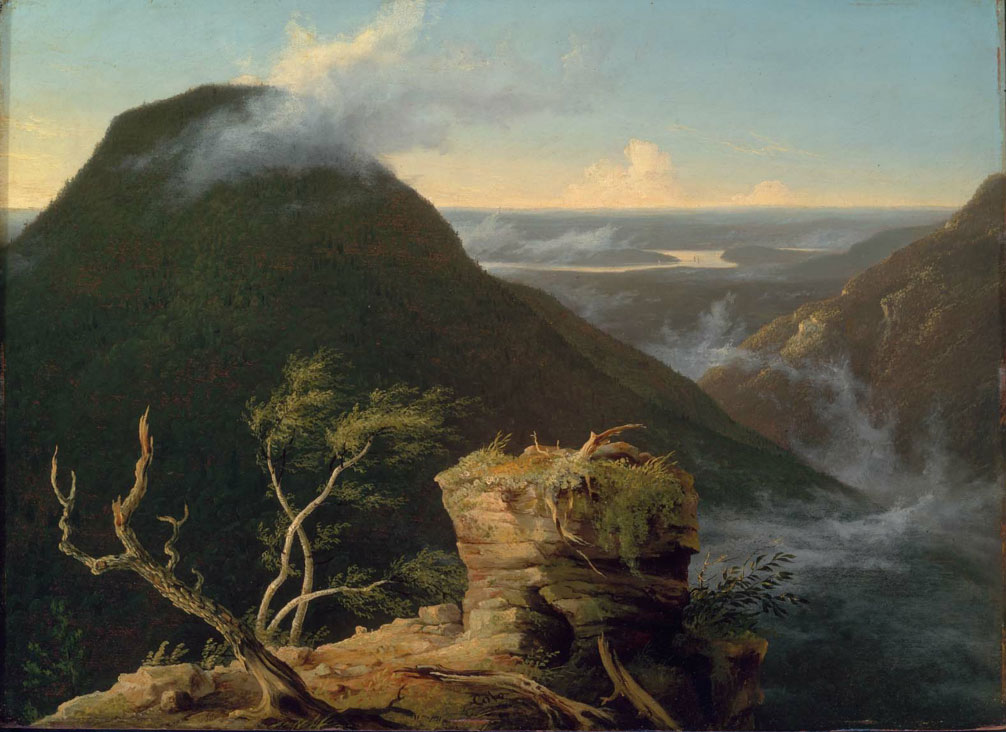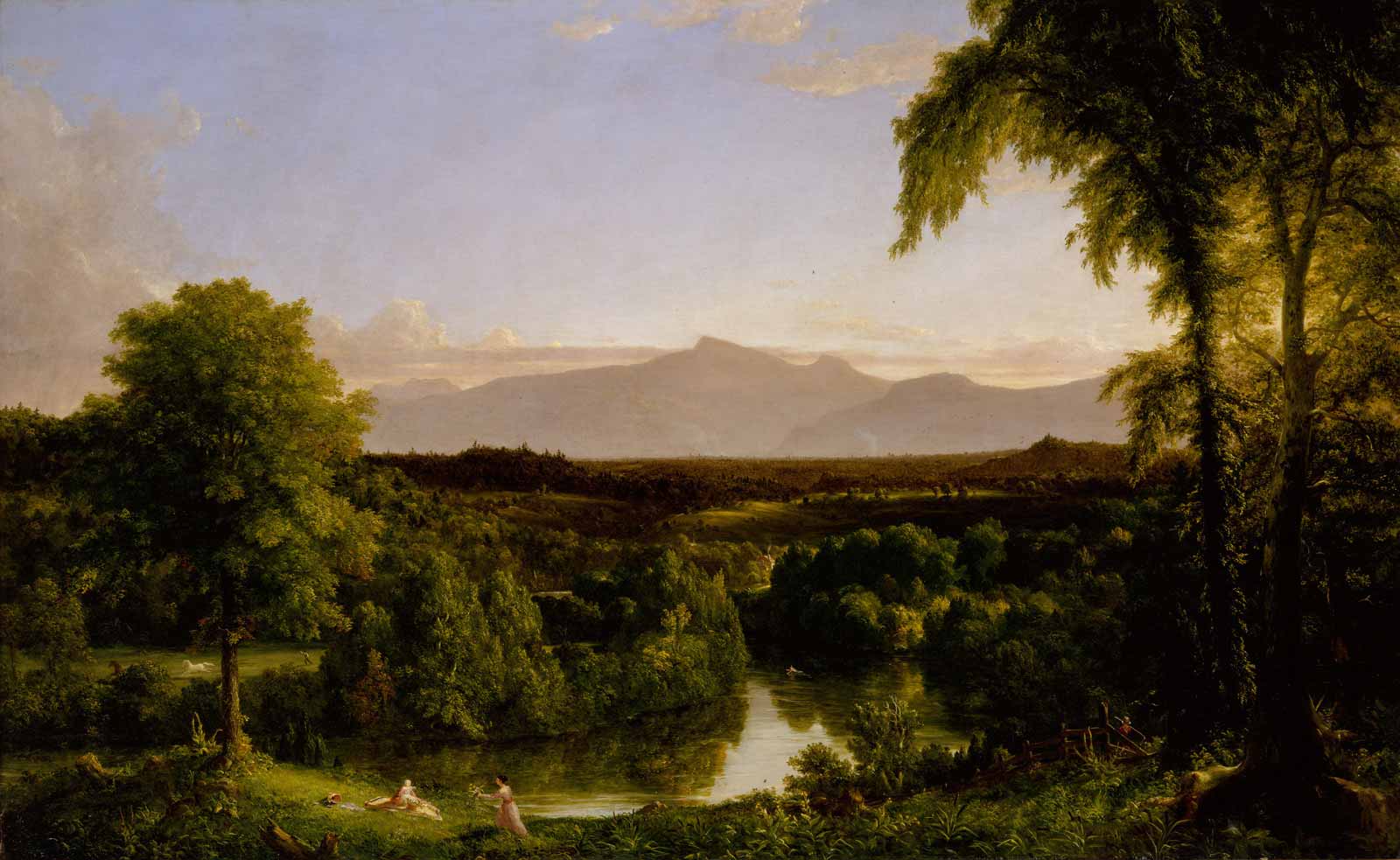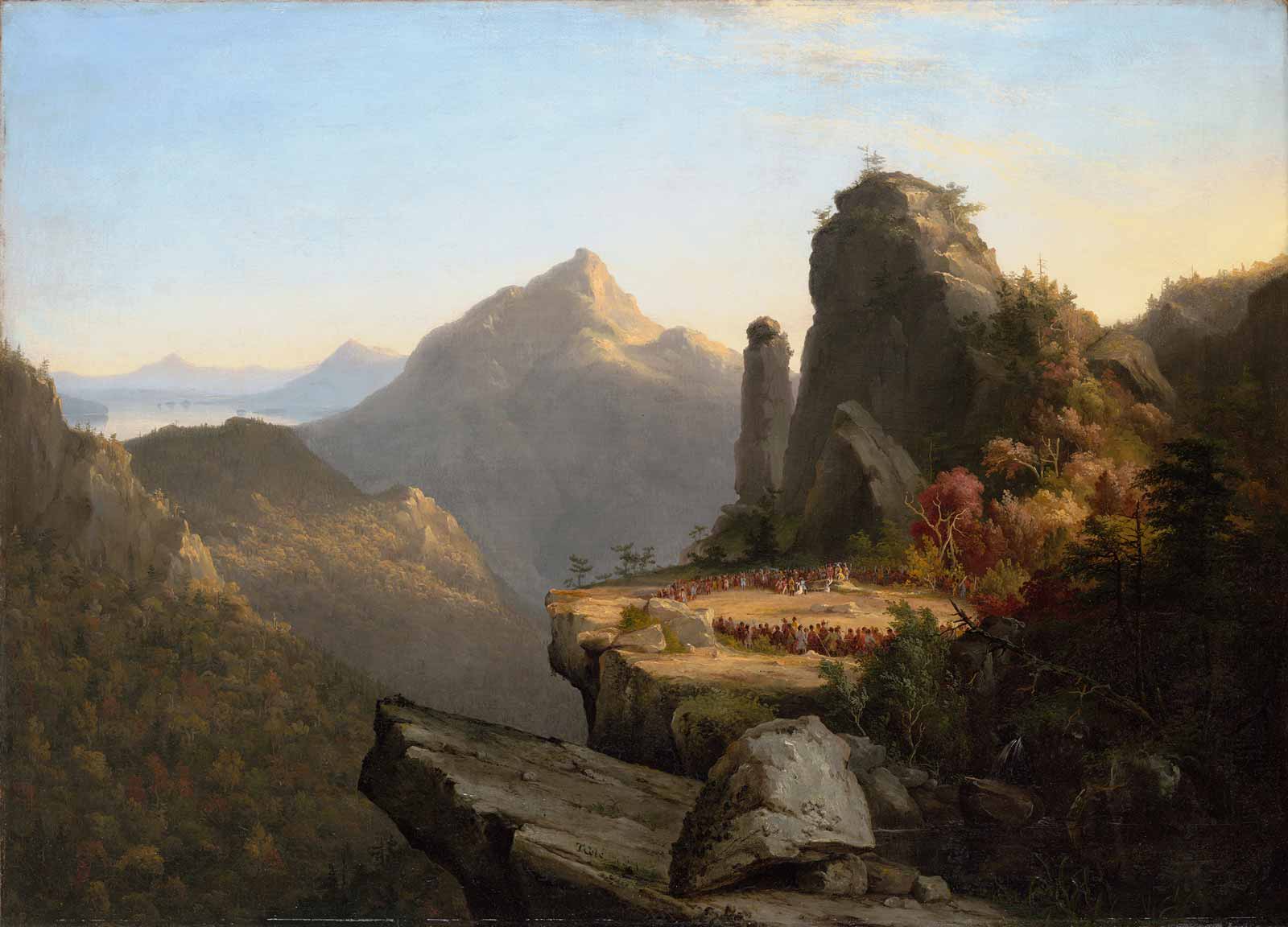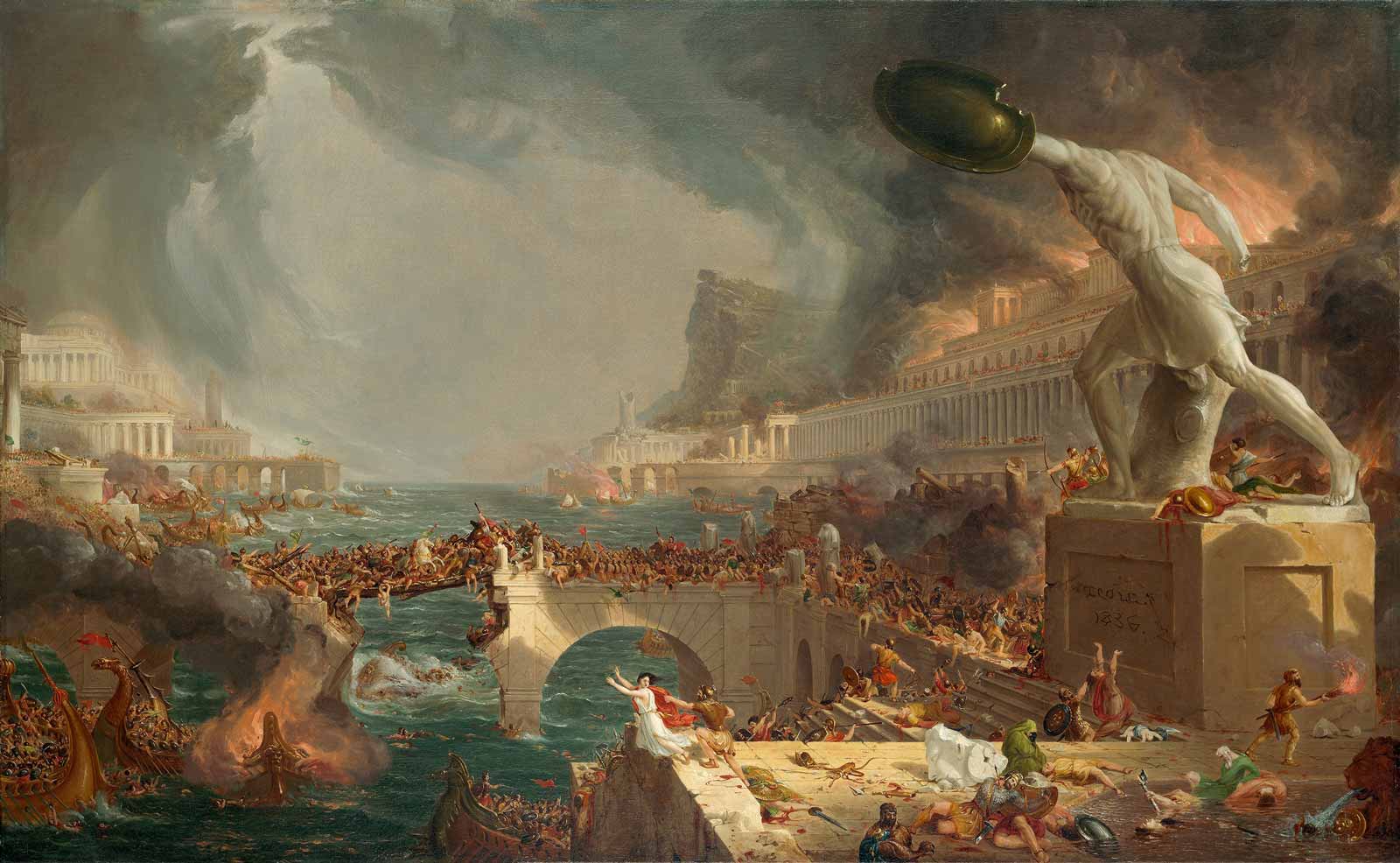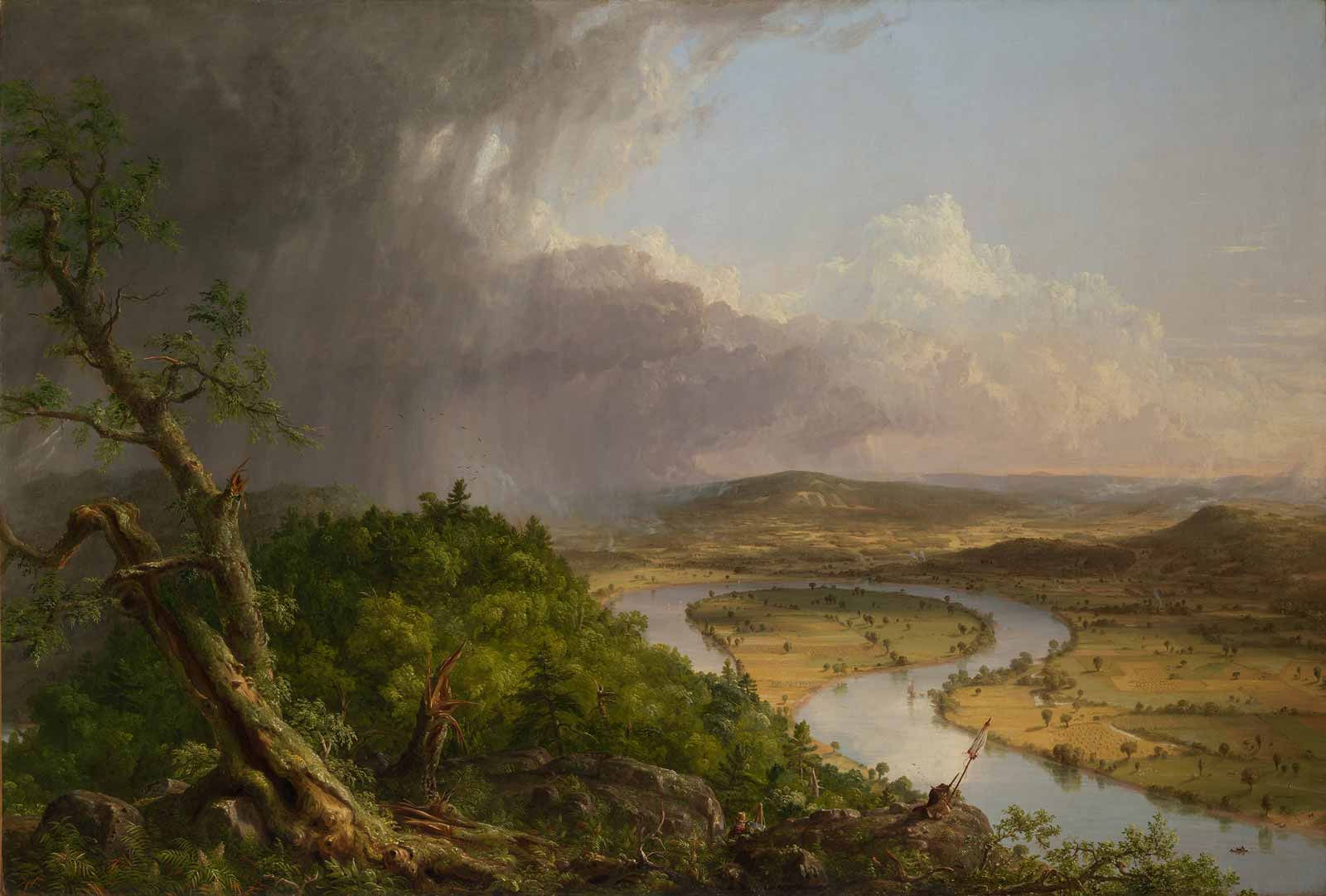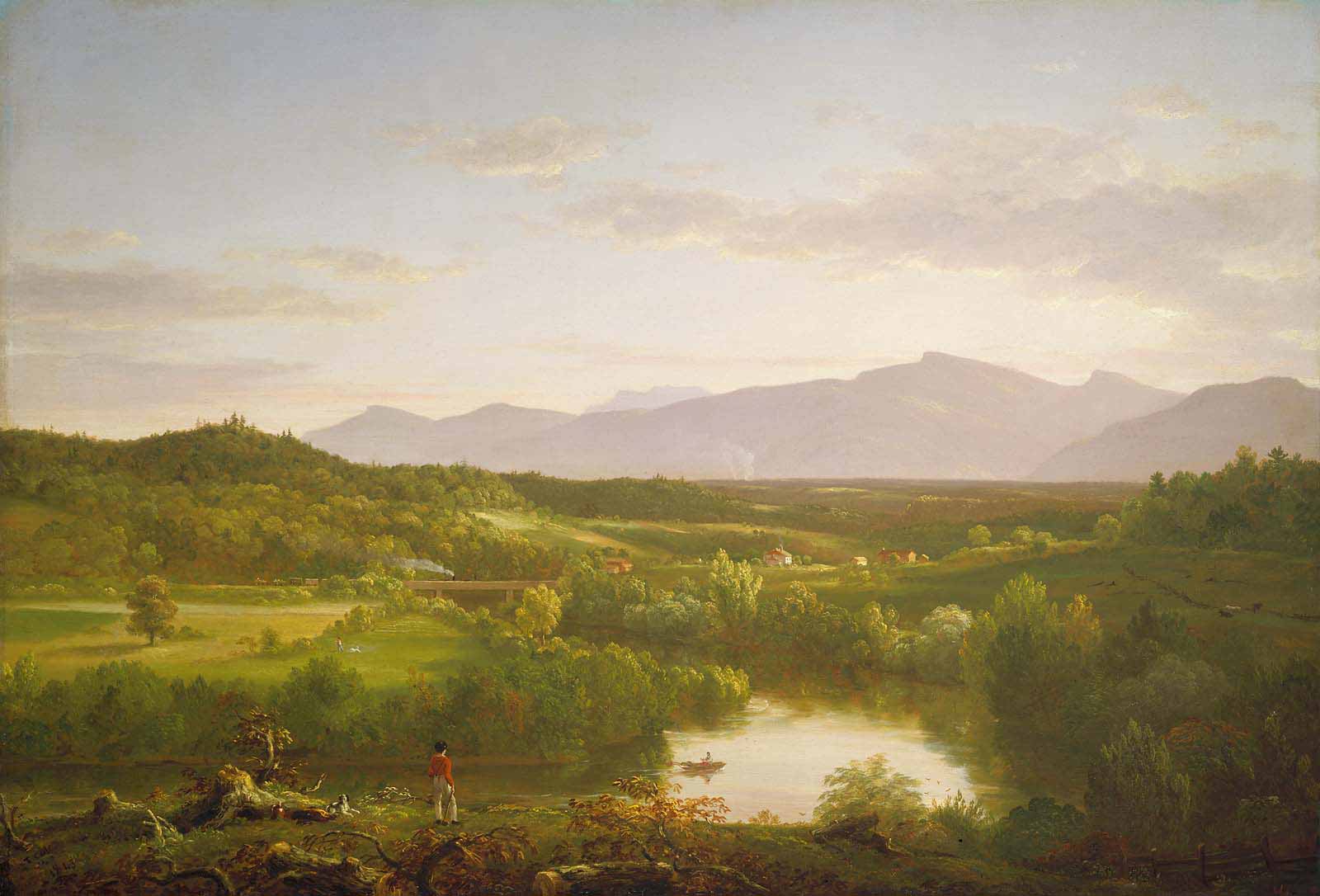Every era gets its own Thomas Cole, the British-born, nineteenth-century artist who ushered in a new age of American landscape painting. In the 1930s and 1940s, he was a precursor to artists like Grant Wood. Come the 1960s and 1970s, MoMA linked his brushwork to abstract expressionism. In the late 1980s, he was part of a Reaganesque “Morning in America” campaign, a Chrysler-sponsored survey of American landscape paintings at the Met. Now, also at the Met, “Thomas Cole’s Journey: Atlantic Crossings” positions Cole as a challenge to Trumpian greed, as well as to the American landscape as imagined by Secretary of the Interior Ryan Zinke and EPA chief Scott Pruitt. But while Cole was undoubtedly concerned with the land he painted, he was not exactly the convenient social critic the Met portrays.
Credited as the force behind the Hudson River School (though the term was not used in his lifetime), Cole created a visual language for a young country. He popularized working from nature, traveling into the mountains and using his sketches there to paint landscapes that were breathtaking and inspiring. He also painted moralizing allegories set in fictional realms, the most famous of which show the development and destruction of empire in stages. Stylistically different, the landscapes often look idyllic, while the pastel, gauzy allegories are sentimental. For years, critics and academics simply saw the latter as an embarrassment. But the current exhibition at the Met links the two to support its portrait of Cole as a proto-conservationist—rightly recognizing the dark message about human nature at the heart of Cole’s work, but applying a contemporary reading of Cole that can be simplistic and anachronistic.
In a line that might be as explicitly political as the Met show gets, art historian Tim Barringer concludes his catalogue essay with a question that he attributes to Cole’s work: “Must the accumulation of wealth always entail overweening greed, leading to imperial exploitation and violence… causing environmental and social ruin?” The implication is that this is still a central question today. But the Met seems to grasp for relevance as many institutions have over the years, creating a Thomas Cole for every moment. The curators ignore the contradictions and issues in his work in favor of pure valorization. In “Atlantic Crossings,” Cole also becomes an “economic migrant” in the introductory video Sting narrates.
To illustrate Cole’s disgust with industrialization, the museum hangs side by side two paintings of the same scene along Catskill Creek near Cole’s home. View on the Catskill, Early Autumn (1836–1837) is bucolic. A young mother runs to her baby with flowers, and according to the Met’s analysis the hunter in the corner is apparently Cole. The thumb-sized figures look cartoonish; painting human figures was never his strength. In the River in the Catskills (1843), the landscape is denuded. A man with an ax stands where the mother and baby had been. A train runs through the view in the distance, portending a coming threat. The rail line had just been built, and Cole wrote angry letters about it to his friends and collectors.
More often Cole created idealized compositions that ignored ordinary people on both sides of colonization—the Native Americans and the pioneers, both. In their place, he crafted glorified scenes of a fictional prelapsarian America, a time “whose gloom,” he wrote, “was peopled by savage beasts, and scarcely less savage men.” When he did paint Native Americans, he used them to convey wilderness, treating them as simply part of a pure landscape—something the Met barely addresses in the show or the catalogue.
Cole may have been a social critic, but his concern was for the land, for nature—not society, not people. I live in the Catskills, where he, too, lived and painted. It’s hardly the same place as when Cole was alive. The region is still poor, but today it’s home to the watershed that supplies New York City and to many second homeowners, rather than the struggling farmers and tanners of Cole’s time. But because industry has all but disappeared from the region, it is also more bucolic now. Cole, though, too often portrayed it as a rural Eden. As a conservationist, he was conservative; he wrote sentimental poetry, quoted in the exhibition catalogue; his sentimental allegories appeared out of fashion even at the time the painted them.
When the young Cole first took a steamer up the Hudson in 1825, tourists had already been to Kaaterskill Falls—made famous two years before by their mention in James Fenimore Cooper’s fiction, in which Natty Bumppo, the archetypal white Anglo protagonist raised by Indians, encounters the falls. A hotel stood nearby, and the British writer and social campaigner Harriet Martineau would soon be another visitor. Both she and Cole found here “Creation… all Creation,” as Cooper wrote. Cole brought with him ego and longing and a need to see the landscape as an expressive force; he left the tourists out of his paintings, and the self-taught Cole quickly won collectors. A few years later, yearning to be a great artist, he set out for Europe to study painting and see the masters. This voyage was the second of the two Atlantic crossings in the show’s title.
Advertisement
The first crossing was occasioned by his family’s fleeing Britain’s industrializing Midlands when Cole was a teenager. His father had tried to become a manufacturer himself. He failed, and for a while, his son Thomas worked in factories as an engraver. In both the catalogue and exhibition text, the Met explores Cole’s later repudiation of rampant industrialism, influenced by what he must have seen as a youth, as well as the experiences that found their way into his work after his second European trip. He returned in 1832, after four years abroad, to a country shaped by Jacksonian democracy, with its greed and factories and destruction of the land. The era also brought mass enfranchisement; every white man was now able to vote. Cole benefitted, too, becoming a US citizen in 1834, but he was no radical; like Cooper, he wanted to preserve the old order for the noble few who’d framed American democracy and had the right to vote.
In the US, the press, patrons, and friends urged Cole to focus on “real American scenes,” but he loved what he called “fancy pictures” or symbolic paintings with a moral. This is the moment in the mid-1830s that the Met calls his “Consummation,” taken from the central painting Consummation of Empire in his five-part Course of Empire (1834–1836). Darkly fatalistic, the series shows humanity’s ruining the earth, which might be a resonant theme today, only the paintings themselves are schlocky. More than one critic has likened their scenes to Cecil B. de Mille films; Cole begins cinematically in an amalgam of ancient realms, perhaps Greece or America before the British, with togas and tipis. The series’ largest, central canvas looks like a mural in a Las Vegas hotel with golden statues and golden ships and hundreds of miniature people lounging around temples and the harbor. But the end is nigh. The city burns in the next scene, finally becoming a ruin at twilight. The Met lays out the cycle’s antecedents, such as Claude Lorrain’s seaport scene, which Cole saw in London and which hangs nearby in this show. Meant as a warning cry to a new country, Cole explains in letters to his patron, the series was nevertheless read at the time by critics as an endorsement of progress, the era’s dominant ideology.
He interrupted work on the cycle to paint View from Mount Holyoke, Northampton, Massachusetts, after a Thunderstorm—The Oxbow (1836), a luminous scene with the Connecticut River circling below and a storm advancing from the west (clouds copied, the Met reveals, from a painting by Turner). Even in Cole’s day, his paintings like The Oxbow were more popular than his allegories, where the meanings were not so symbolic, and where Cole’s real talent for painting vegetation shines (the Met shows his drawings of trees from the early 1820s dating from his earliest work).
Painted from his sketches in nature, The Oxbow has always been my favorite Cole. On one side is development, on the other wilderness; in the foreground is a dramatic, gnarled stump straight from Salvator Rosa, which often appeared in his compositions. Just below is a tiny Thomas Cole, poking his head up to look at the viewer. The distant self-portrait, intended, according to the Met, as a dramatic direct address, is unintentionally comical. Also humorous to note, he painted The Oxbow from a popular tourist sight, but eradicated all signs of visitors.
Cole’s “Essay on American Scenery” was published in 1836, the same year as Emerson’s “Nature.” The tract established him as a critic of industry and an exponent of transcendent nature, akin to Emerson, though with a more righteous God: “Whether he beholds the Hudson mingling waters with the Atlantic—explores the central wilds of this vast continent, or stands on the margin of the distant Oregon, he is still in the midst of American scenery—it is his own land; its beauty, its magnificence, its sublimity—all are his.” This “all are his” could point to a democratized transcendence or a bid for ownership like the claim of Manifest Destiny. Or both. Or neither: a wilderness without people, and in his conclusion he declares, “We are still in Eden.”
Advertisement
Originally delivered as a lecture in 1835, the essay was meant to instruct readers on how to view nature and why America’s landscape was greater than Europe’s. He complained about the country’s being “desecrated by what is called improvement.” He despised how the Catskills’ forests were being cleared for farming, while the region’s tanning industry peeled bark from hemlocks for the tannins, leaving the trees to die, and polluting the rivers. In a letter to a patron, he decried those who felled forests: “Copper-hearted barbarians.”
Cole wanted to preserve the Catskills, but in his writing and painting he too often ignored the farmers and tanners who lived there and struggled to get by. These people were my neighbors’ forebears and were in debt to wealthy landlords like the Livingston family, who, at the time, owned a majority of the land on both sides of the Hudson. The tenant farmers would girdle trees and burn out the stumps while landlords charged onerous rents and retained the rights to any ore, mills, or mines on the land—even any waterfall that might one day power a mill. Those who peeled bark for tanning didn’t fare any better. They’d cover themselves in bear fat to protect themselves from the hemlock’s pitch.
Life became harder for these people with the Panic of 1837, a recession that lasted into the 1840s. A land boom fueled by easy credit collapsed as banks tightened lending, first in the UK, then the US. Commodities plummeted and unemployment soared. The crisis exacerbated New England’s agricultural issues with exhausted farmland. Displaced farmers moved to cities, where anti-immigrant riots flared amid race-to-the-bottom factory employment. Some took up radical means; utopian socialism spread and Shaker membership exploded. Catskills farmers aligned with socialists in Williamsburg and took up arms to fight the landlords. The farmers lost. The governor called out the militia, and in the autumn of 1845, the uprising’s prisoners were marched past Cole’s house.
Cole can hardly have been unaware of the privations suffered by the working people who were his neighbors, but he never addressed the subject directly. Perhaps the closest he came to doing so was when he began an open commission for a wealthy client, in which Cole chose the subject. It’s not in the exhibition but at the Brooklyn Museum. A Pic-Nic Party (1846) depicts a group with picnic baskets and blankets assembled on Catskill Creek, a guitarist serenading them. It seems to exhort people, average people, to get out in nature for a picnic—something that should be accessible to the masses. In the context of the economic crisis of the 1840s, though, it points more to Cole’s obliviousness than any real concern for the downtrodden.
A few years ago, I made a pilgrimage to Cole’s home, Cedar Grove, in Catskill, New York. It was early autumn, the time of year he’d first come upstate in 1825. What I found most moving after seeing the Met’s exhibition was Cole’s longing. In his youth, Cole had yearned for “the glory of being a great painter.” Before he left for his return journey to England, he said he felt like “one going to a great battle.” Later in life, he complained that people hadn’t understood his paintings, and expressed regret that so much of his work had been tainted by the demands of patrons and the need to make money.
Instead of working according to the dictates of feeling and imagination, I have painted to please others in order to exist… my imagination should not have been cramped, as it had been; and I would have followed out principles of beauty and sublimity in my works, which have been cast aside, because the result would not be marketable.
“Thomas Cole’s Journey: Atlantic Crossings” is at the Metropolitan Museum of Art through May 13.


